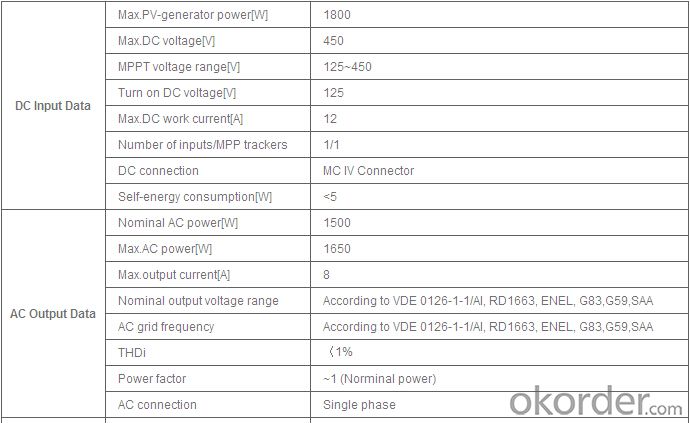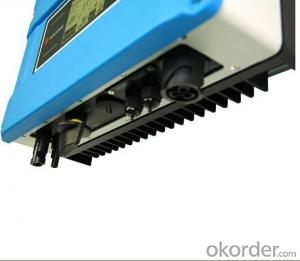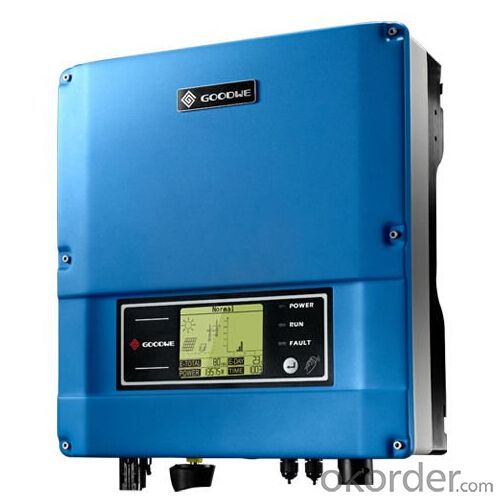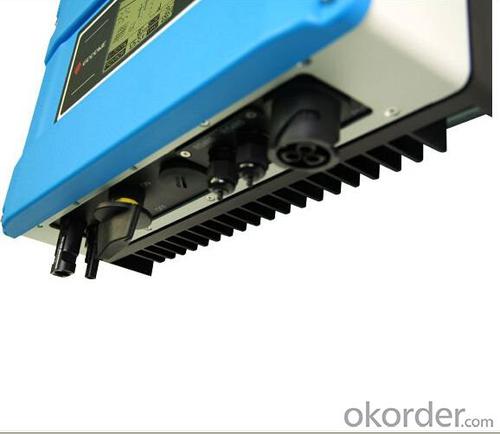Bluesun Solar Inverter GW1500-SS On Grid Solar Inverter
OKorder Service Pledge
Quality Product, Order Online Tracking, Timely Delivery
OKorder Financial Service
Credit Rating, Credit Services, Credit Purchasing
You Might Also Like
GW1500-SS photovoltaic inverter
is suitable for home rooftop photovoltaic system, designed under modern industrial concept.
There are three colors for option with fashionable appearance.
This model is applicable for the photovoltaic system with open-circuit voltage less than 450V,
maximum output power less than 1800W. Its maximum conversion efficiency can reach 97%.
First-class harmonic control ability, small size and light weight make it hold a safe lead among similar products.
Datasheet

- Q: How does the input frequency range affect the performance of a solar inverter?
- The input frequency range directly affects the performance of a solar inverter. The inverter is designed to convert the variable direct current (DC) generated by the solar panels into stable alternating current (AC) that can be used by household appliances or fed into the grid. If the input frequency deviates from the specified range, it can lead to inefficient or unstable operation of the inverter. A wider input frequency range allows the inverter to handle fluctuations in the solar power generation, ensuring optimal performance and compatibility with different grid conditions.
- Q: Can a solar inverter be used with a solar-powered agriculture system?
- Yes, a solar inverter can be used with a solar-powered agriculture system. A solar inverter is essential for converting the direct current (DC) electricity produced by solar panels into alternating current (AC) electricity required to power electrical devices and equipment used in the agriculture system. This allows for the efficient utilization of solar energy for various agricultural applications such as irrigation systems, pumps, lighting, and other electrical equipment.
- Q: After the PV inverter, how to achieve the same period before the network?
- When the voltage, frequency, phase does not meet the requirements, the automatic closing closing pulse.
- Q: How does a solar inverter handle voltage phase imbalance in the grid?
- A solar inverter handles voltage phase imbalance in the grid by monitoring the phase angles of the grid voltage and adjusting its output accordingly. It continuously measures the phase imbalance and corrects it by injecting reactive power into the grid. This helps to balance the voltage across the different phases and maintain stable grid conditions.
- Q: What are the different power output modes of a solar inverter?
- The different power output modes of a solar inverter include grid-tied mode, off-grid mode, and hybrid mode. In grid-tied mode, the solar inverter synchronizes with the utility grid, allowing excess solar energy to be fed back into the grid. In off-grid mode, the inverter operates independently, powering electrical loads directly from solar energy and often utilizing batteries for energy storage. Hybrid mode combines both grid-tied and off-grid functionality, allowing the inverter to switch between grid-connected and standalone operation as needed.
- Q: What is the efficiency rating of a solar inverter?
- The efficiency rating of a solar inverter refers to the percentage of solar energy that is converted into usable electricity. It is a measure of how effectively the inverter can convert the direct current (DC) output from the solar panels into alternating current (AC) electricity that can be used to power household appliances or be fed back into the grid. The higher the efficiency rating, the more efficient the inverter is at converting solar energy into electricity.
- Q: What are the different output waveforms of a solar inverter?
- The different output waveforms of a solar inverter can vary depending on the type of inverter being used. The most common types include pure sine wave, modified sine wave, and square wave. Pure sine wave inverters produce an output waveform that closely resembles the standard AC power provided by utility companies, making them ideal for powering sensitive electronics. Modified sine wave inverters produce a stepped waveform that may not be as smooth as a pure sine wave, but can still power most household appliances. Square wave inverters produce a more basic waveform with abrupt transitions between positive and negative voltage, typically used for powering simple devices or tools.
- Q: What maintenance is required for a solar inverter?
- Regular maintenance is required for a solar inverter to ensure its optimal performance. This includes cleaning the inverter and its components to remove any dust or debris, inspecting and tightening electrical connections, checking and replacing any faulty or worn-out parts, monitoring the inverter's performance and efficiency, and keeping track of any software updates or firmware upgrades provided by the manufacturer. It is also important to regularly clean and maintain the solar panels and other associated equipment to ensure the inverter's functionality.
- Q: What is the warranty period for a solar inverter?
- The warranty period for a solar inverter can vary depending on the manufacturer and model, but it typically ranges from 5 to 10 years.
- Q: Are solar inverters weatherproof?
- Yes, solar inverters are weatherproof. They are designed to withstand various weather conditions including rain, snow, and extreme temperatures. The enclosures of solar inverters are typically made of durable materials that provide protection against moisture and other environmental factors.
Send your message to us
Bluesun Solar Inverter GW1500-SS On Grid Solar Inverter
OKorder Service Pledge
Quality Product, Order Online Tracking, Timely Delivery
OKorder Financial Service
Credit Rating, Credit Services, Credit Purchasing
Similar products
Hot products
Hot Searches
Related keywords
























